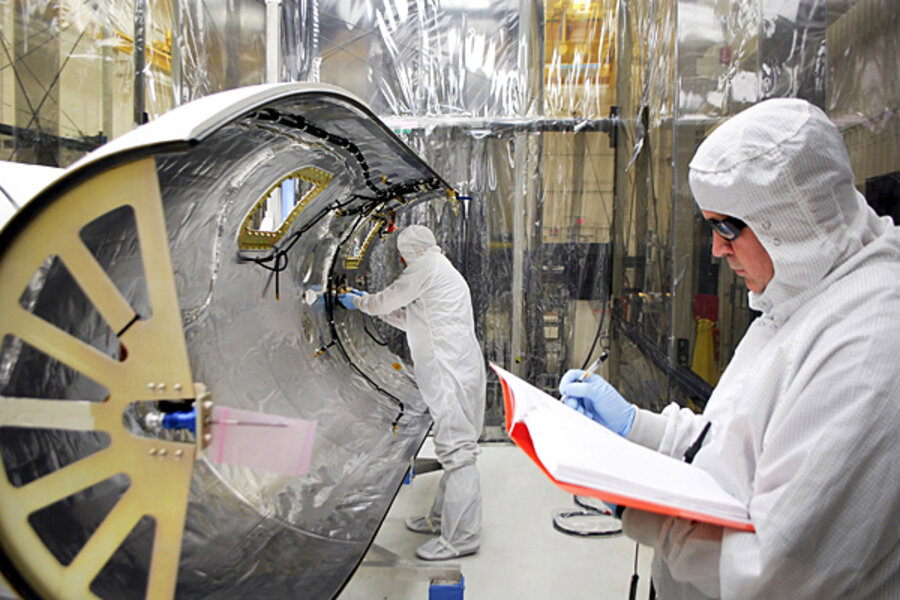NASA launching IRIS, a new eye on poorly understood region of sun
Loading...
NASA is set to launch a space telescope Thursday night that is designed to explore the sun's version of terra incognita – a region between the sun's lower atmosphere and its expansive outer atmosphere blandly dubbed the interface region.
Indeed, for understanding some of the sun's processes, solar physicists didn't need to know what was going on there, earning it the title "ignorosphere," notes Ed DeLuca, a solar physicist at the Harvard-Smithsonian Center for Astrophysics in Cambridge, Mass.
But over the past five to 10 years, as physicists developed models to more fully represent the sun's processes, it became clear that the ignorosphere could be ignored no longer.
It's the region that generates most of the ultraviolet light the sun delivers to Earth, affecting everything from sun tans to atmospheric chemistry and climate. It's thought to play a key role in the solar outbursts that can disrupt power grids and satellite navigation. And, mysteriously, it's the region where temperatures in the sun's atmosphere soar.
At the top of the sun's lower atmosphere, known as the chromosphere, temperatures rise from about 10,000 degrees at the sun's surface to roughly 36,000 degrees. Processes in the interface region – only about 200 miles thick – kick those temperatures up to 1 million degrees F., feeding an even hotter outer atmosphere, or corona. There, temperatures are comparable to those in the sun's core.
Getting a handle on what's happening in the interface region is challenging because the region is so thin and because the processes taking place there are so fast. And with more mass than all the matter in the corona or in the solar wind currently flowing through the solar system, the interface region's density can make it hard to observe.
Hints of just how fast processes are have come from Japan's Hinode orbiting solar observatory.
Taking one image every 4 seconds, the craft delivered data that allowed researchers to produce a short video starring a dense forest of hair-like tendrils of plasma rising through the interface region. These represent the central cores of jets of hot gas that rise to give the top of the interface region the look – from a distance – of rolling hills.
The hair-like cores are about 100 miles wide and some 10,000 miles long, said Alan Title, a solar physicist with Lockheed Martin Corporation and the mission's lead scientist, during a prelaunch briefing. They rocket up through the transition region at about 270,000 miles an hour, and last for about 10 minutes before vanishing, only to be replaced by fresh tendrils.
The images Hinode captured were scientifically useful. But seeing them, scientists also realized "for the first time that four-second exposures and just one wavelength [of light] wasn't enough" to see the full structures, Dr. Title said
NASA’s new solar telescope, known as IRIS, aims to remedy that.
As satellites go, it's a lightweight. Some seven feet long, the craft and its telescope weigh 403 pounds. IRIS is set for launch between 10:27 and 10:32 p.m. Eastern Daylight Time tonight from Vandenberg Air Force Base on the central California coast. It's being launched on an Orbital Sciences Pegasus rocket – a launch vehicle carried aloft underneath an L-1011 jet, then release for its final ascent.
IRIS has 20 times the ability of previous telescopes to see fine details. Its instrument, an imaging spectrometer, can make measurements 20 times faster than its predecessors. And it is designed to gather ultraviolet light at several groups of wavelengths.
And that's a good thing, Dr. DeLuca says, because if the models are correct, processes in the interface zone are nothing if not complicated.
From the sun's core through its surface, the photosphere, the sun's hot gas is dense enough to twist and contort the star's magnetic fields, DeLuca explains. Up in the corona, the reverse it true, with magnetic fields working their will on the hot gas, giving shape to the enormous, glowing coronal loops that appear there.
In the ignorosphere, however, magnetic fields hold sway over gas in some areas. In others, the opposite happens. And still other regions neither gas nor magnetism holds sway over the other, DeLuca says. The shapes of structures in this region are equally complex.
Still, to understand the corona's energy budget and the role magnetic fields play in transferring energy from the sun's surface to the corona, getting a handle on the interface region is important.
"It's all gotta go through the chromosphere and interface region," he says.







